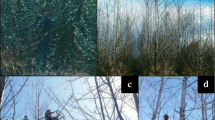Abstract
The study demonstrates the production of a transgenic Scots pine (Pinus sylvestris L.) seedling through the application of transformed pollen in controlled crossings. The pollen lots were transformed by particle bombardment, resulting in transient transformation frequencies varying from 15 to 49% of the germinated pollen grains, and bombarded pollen was used to pollinate megasporangiate strobili. Progeny was screened by histochemical, GUS assays, and selected seedlings were further analysed by PCR. PCR amplification revealed the presence of both the nptII and gusA genes in one seedling (23/237). Results were confirmed by Southern blot analysis. The morphology and growth of this transgenic seedling was normal. Although the transformation frequency of recovered plants was very low (1/14999), the present protocol suggests that production of transgenic Scots pine is possible without the use of any tissue culture methods or the involvement of marker genes, for selection of transformants.
Similar content being viewed by others
References
Aronen T and Häggman H (1995) Differences in Agrobacterium infections in silver birch and Scots pine. Eur J Forest Pathol 25: 197–213.
Aronen T, Häggman H and Hohtola A (1994) Transient β-glucuronidase expression in Scots pine tissues derived from mature trees. Can J Forest Res 24: 2006–2011.
Aronen T, Nikkanen T and Häggman H (1998) Compatibility of different pollination techniques with microprojectile bombardment of Norway spruce and Scots pine. Can J Forest Res 28: 79–86.
Binet M-N, Lepetit M, Weil J-H and Tessier L-H (1991) Analysis of sunflower polyubiquitin promoter by transient expression. Plant Sci 79: 87–94.
Bishop-Hurley SL, Zabkiewicz RJ, Grace L, Gardner RC, Wagner A and Walter C (2001) Conifer genetic engineering: transgenic Pinus radiata (D. Don) and Picea abies (Karst) plants are resistant to the herbicide Buster. Plant Cell Rep 20: 235–243.
Charest P, Devantier Y and Lachance D (1996) Stable genetic transformation of Picea mariana (Black spruce) via particle bombardment. In vitro Cell Dev B 32: 91–99.
Daniell H, Wiebe PO and Millan AF-S (2001) Antibiotic-free chloroplast genetic engineering. Trends Plant Sci. 100: 5 sivua.
Doyle JJ and Doyle JL (1990) Isolation of plant DNA from fresh tissue. BRL Focus 12: 13–15.
Ferguson MC (1901) The development of the pollen-tube and the division of the generative nucleus in certain species of pines. Ann Bot-London XV: 193–223, 224-229.
Fernando DD, Owens JN and Misra S (2000) Transient gene expression in pine pollen tubes following particle bombardment. Plant Cell Rep 19: 224–228.
Hawkins S, Samaj J, Lauvergeat V, Boudet A and Grima-Pettenati J (1997) Cinnamyl alcohol dehydrogenase: identification of new sites of promoter activity in transgenic poplar. Plant Physiol 113: 321–325.
Hay I, Lachance D, von Aderkas P and Charest PJ (1994) Transient chimeric gene expression in pollen of five conifer species following microparticle bombardment. Can J Forest Res 24: 2417–2423.
Häggman H and Aronen T (1998) Transgene expression in regenerating cotyledons and embryogenic cultures of Scots pine. J Exp Bot 49: 1147–1156.
Häggman HM, Aronen TS and Nikkanen TO (1997) Gene transfer by particle bombardment to Norway spruce and Scots pine pollen. Can J Forest Res 27: 928–935.
Jefferson R (1987) Assaying chimeric genes in plants: the GUS gene fusion system. Plant Mol Biol Rep 5: 387–405.
Levee V, Garin E, Klimaszewska K and Seguin A (1999) Stable genetic transformation of white pine (Pinus sylvestris L.) after cocultivation of embryogenic tissues with Agrobacterium tumefaciens. Mol Breeding 5: 429–440.
Li Y-h, Tremblay T and Séguin A (1994) Transient transformation of pollen and embryogenic tissues of white spruce (Picea glauca (Moench.) Voss) resulting from microprojectile bombardment. Plant Cell Rep 13: 661–665.
Lodhi MA, Ye G-N, Weeden NF and Reisch BI (1994) A simple and efficient method for DNA extraction from grapevine cultivars and Vitis species. PlantMol Biol Rep 12: 6–13.
Martinussen I, Junttila O and Twell D (1994) Optimization of transient gene expression in pollen of Norway spruce (Picea abies) by particle acceleration. Physiol Plantarum 92: 412–416.
Moitra A and Bhatnagar SP (1982) Review article: ultrastructure, cytochemical, and histochemical studies on pollen and male gamete development in gymnosperms. Gamete Res 5: 71–112.
Regan S, Bourquin V, Tuominen H and Sundberg B (1999) Accurate and high resolution in situ hybridization analysis of gene expression in secondary stem tissues. Plant J 19: 363–369.
Robertson D, Weissinger A, Ackley R, G lover S and Sederoff R (1992) Genetic transformation of Norway spruce (Picea abies (L.) Karst) using somatic embryo explants by microprojectile bombardment. Plant Mol Biol 19: 925–935.
Stoger E, Fink C, Pfosser M and Heberle-Bors E (1995) Plant transformation by particle bombardment of embryogenic pollen. Plant Cell Rep 14: 273–278.
Tang W, Sederoff R and Whetten R (2001) Regeneration of transgenic loblolly pine (Pinus taeda L.) from zygotic embryos transformed with Agrobacterium tumefaciens. Planta 213: 981–989.
Tuominen H, Puech L, Regan S, Fink S, Olsson O and Sundberg B (2000) Cambial-region-specific expression of the Agrobacterium iaa genes in transgenic aspen visualized by a linked uidA reporter gene. Plant Physiol 123: 531–541.
Valjakka M, Aronen T, Kangasjärvi J, Vapaavuori E and Häggman H (2000) Genetic transformation of silver birch (Betula pendula) by particle bombardment. Tree Physiol 20: 607–613.
Walter C, Grace LJ, Wagner A, White DWR, Walden A, Donaldson SS et al. (1998) Stable transformation and regeneration of transgenic plants of Pinus radiata D. Don. Plant Cell Rep 17: 460–468.
van der Leede-Plegt LM, van de Ven BCE, Schilder M, Franken J and van Tunen A (1995) Development of a pollen-mediated transformation method for Nicotiana glutinosa. Transgenic Res 4: 77–86.
Author information
Authors and Affiliations
Corresponding author
Rights and permissions
About this article
Cite this article
Aronen, T.S., Nikkanen, T.O. & Häggman, H.M. The Production of Transgenic Scots Pine (Pinus Sylvestris L.) via the Application of Transformed Pollen in Controlled Crossings. Transgenic Res 12, 375–378 (2003). https://doi.org/10.1023/A:1023310009902
Issue Date:
DOI: https://doi.org/10.1023/A:1023310009902




